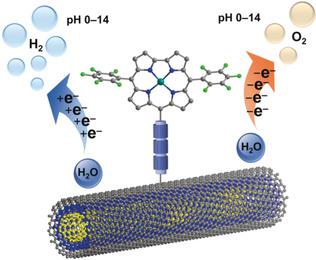当前位置:
X-MOL 学术
›
Angew. Chem. Int. Ed.
›
论文详情
Our official English website, www.x-mol.net, welcomes your feedback! (Note: you will need to create a separate account there.)
Carbon Nanotubes with Cobalt Corroles for Hydrogen and Oxygen Evolution in pH 0–14 Solutions
Angewandte Chemie International Edition ( IF 16.6 ) Pub Date : 2018-10-18 , DOI: 10.1002/anie.201807996 Xialiang Li 1 , Haitao Lei 1 , Jieyu Liu 2 , Xueli Zhao 1 , Shuping Ding 1 , Zongyao Zhang 3 , Xixi Tao 4 , Wei Zhang 1 , Weichao Wang 2 , Xiaohong Zheng 4 , Rui Cao 1, 3
Angewandte Chemie International Edition ( IF 16.6 ) Pub Date : 2018-10-18 , DOI: 10.1002/anie.201807996 Xialiang Li 1 , Haitao Lei 1 , Jieyu Liu 2 , Xueli Zhao 1 , Shuping Ding 1 , Zongyao Zhang 3 , Xixi Tao 4 , Wei Zhang 1 , Weichao Wang 2 , Xiaohong Zheng 4 , Rui Cao 1, 3
Affiliation

|
Water splitting is promising to realize a hydrogen‐based society. The practical use of molecular water‐splitting catalysts relies on their integration onto electrode materials. We describe herein the immobilization of cobalt corroles on carbon nanotubes (CNTs) by four strategies and compare the performance of the resulting hybrids for H2 and O2 evolution. Co corroles can be covalently attached to CNTs with short conjugated linkers (the hybrid is denoted as H1) or with long alkane chains (H2), or can be grafted to CNTs via strong π–π interactions (H3) or via simple adsorption (H4). An activity trend H1≫H3>H2≈H4 is obtained for H2 and O2 evolution, showing the critical role of electron transfer ability on electrocatalysis. Notably, H1 is the first Janus catalyst for both H2 and O2 evolution reactions in pH 0–14 aqueous solutions. Therefore, this work is significant to show potential uses of electrode materials with well‐designed molecular catalysts in electrocatalysis.
中文翻译:

含钴的碳纳米管可在pH 0-14溶液中释放氢和氧
水的分解有望实现一个以氢为基础的社会。分子水分解催化剂的实际使用取决于它们与电极材料的结合。我们在本文中描述了通过四种策略将钴醇固定在碳纳米管(CNTs)上的情况,并比较了所得杂化物对H 2和O 2演化的性能。助酚可以通过短共轭接头(杂合体表示为H1)或长烷烃链(H2)与碳纳米管共价连接,也可以通过强π-π相互作用(H3)或简单吸附(H4)接枝到CNT上。)。活动趋势H1 » H3 > H2≈ H4被用于h获得2和O 2的演变,示出的上电催化电子转移能力的关键作用。值得注意的是,H1是第一种在pH 0-14水溶液中发生H 2和O 2析出反应的Janus催化剂。因此,这项工作对于显示具有良好设计的分子催化剂的电极材料在电催化中的潜在用途具有重要意义。
更新日期:2018-10-18
中文翻译:

含钴的碳纳米管可在pH 0-14溶液中释放氢和氧
水的分解有望实现一个以氢为基础的社会。分子水分解催化剂的实际使用取决于它们与电极材料的结合。我们在本文中描述了通过四种策略将钴醇固定在碳纳米管(CNTs)上的情况,并比较了所得杂化物对H 2和O 2演化的性能。助酚可以通过短共轭接头(杂合体表示为H1)或长烷烃链(H2)与碳纳米管共价连接,也可以通过强π-π相互作用(H3)或简单吸附(H4)接枝到CNT上。)。活动趋势H1 » H3 > H2≈ H4被用于h获得2和O 2的演变,示出的上电催化电子转移能力的关键作用。值得注意的是,H1是第一种在pH 0-14水溶液中发生H 2和O 2析出反应的Janus催化剂。因此,这项工作对于显示具有良好设计的分子催化剂的电极材料在电催化中的潜在用途具有重要意义。


























 京公网安备 11010802027423号
京公网安备 11010802027423号